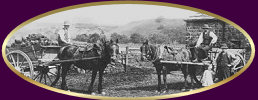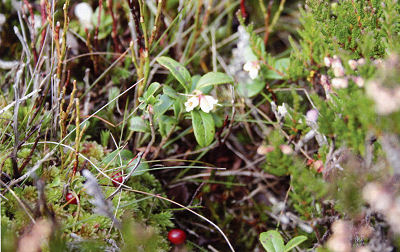

Botany in Lunedale
By Margaret E Bradshaw MBE, PhD
The Lune is a major tributary of the Tees, which it enters a short distance below Middleton-in-Teesdale. It drains the southern and eastern slopes of Mickle Fell (2591ft, 788m) and Little Fell (2446ft, 753m) respectively, two of the higher summits of the northern Pennines and falls to 912ft (250m) just below the dam of Grasshoime reservoir at the east end of the Lunedale Heritage Project area.
The vegetation and flora are closely linked to the geology of the area. This is of the Yoredale series of repeated strata of shale, limestone and sandstone, with the highest summits capped by the very coarse millstone-grit sandstone. There are many faults and mineral veins and small areas of the intruded dolerite known as whinsill.
Below the higher tops the country rocks were covered with glacial deposits that have subsequently been eroded away in places leaving the harder rocks exposed, often as small cliffs.
As a result of this varied geology and altitudinal range, Lunedale is clothed with many different types of vegetation. By the Lune the small shingle beds are too unstable for many plants to become established. On the sides are meadows and pastures. Some meadows are of the herb-rich type as in the SSSI near Grains o' Beck and that at West Park, characteristic plants are wood cranesbill, globeflower, melancholy thistle, common bistort, Lady's mantle, pignut, bulbous buttercup, Yellow-rattle, meadowsweet, water avens, greater burnet, ragged robin.
Steep and uncut banks may have betony, common spotted and early purple orchids, marsh valerian, alpine bistort, lesser stitchwort, bitter vetch and marsh marigold in the wetter parts; frequent grasses are sweet vernal grass, smooth and rough stalked meadow grass, meadow foxtail, hairy oat-grass, golden oat-grass, quaking grass, common bent and red-fescue.
Pastures, also, show considerable variation: the lower ones have a tight, low-growing sward or a fairly lush, taller growth. Red fescue, common bent and crested dog's tail are frequent, with sweet vernal grass and Yorkshire fog. Flowering plants include bird's foot trefoil, ribworth plantain, red and white clover, hardheads, buttercups, sorrel, cat's-ear, dandelion, yarrow and Lady's mantles. These pastures are increasingly being invaded by the soft and jointed rushes.
 Higher
on the fells and by the streams are areas of short turf dominated by sheep's
fescue and common bent with crested dog's tail, heath bedstraw, tormentil,
common dog violet, buttercup, selfheal, milkwort, eye-bright and occasional
plants of wiry mat-grass. This merges into a more acid vegetation dominated
by mat-grass with wavy hair-grass, tormentil and heath bedstraw and heath
rush. Over thin peats on the drier, acidic slopes is heath vegetation of
ling, bilberry, cowberry and wavy hairgrass.
Higher
on the fells and by the streams are areas of short turf dominated by sheep's
fescue and common bent with crested dog's tail, heath bedstraw, tormentil,
common dog violet, buttercup, selfheal, milkwort, eye-bright and occasional
plants of wiry mat-grass. This merges into a more acid vegetation dominated
by mat-grass with wavy hair-grass, tormentil and heath bedstraw and heath
rush. Over thin peats on the drier, acidic slopes is heath vegetation of
ling, bilberry, cowberry and wavy hairgrass.
In the basins and at higher altitude where deep peat has developed are various bog communities with ling, cross-leaved heather, tufted cotton-grass (draw-moss) - a valuable sheep-feed in winter, common cotton-grass which turns wine-red in autumn and deer-grass. In areas like Mickle Fell brocks, the blanket bog is deeply eroded with bare peat showing on the sides of the 'hags', on the tops are ling, cross-leaved heather and crowberry, especially near the drier edges. Much erosion occurs in heavy rain.
The limestone cliffs support a flora that includes some of the Teesdale specialities (blue moor-grass, hoary whitlow-grass, thyme, crested hair-grass, limestone and northern bedstraw, harebell, wall-rue and maidenhair and green spleenworts.) In the turf below such cliffs is a species-rich bent-fescue turf with blue moor-grass, quaking grass, least clubmoss, moon-wort, harebell, thyme, limestone bedstraw and occasional spring gentians.
At the very highest levels of Mickle Fell and Little Fell are two treasures of Lunedale - the very rare alpine forget-me-nott and spring gentiant in a species-rich turf with blue moor-grass, sheep's fescue and common bent. There is very little woodland in Lunedale.
Near Wemmergill is an ancient birch wood that once may have contained oaks. The floor is thickly covered with mosses including bog-moss and ferns are common: broad buckler fern, male fern, hard fern and polypody; other plants include enchanter's nightshade, bird's foot trefoil, rough hawkbit, marsh bedstraw, marsh willow-herb, marsh violet, marsh ragwort, yellow pimpernel, purple moor-grass, greater wood-rush and heath rush. There are small patches of trees on the sides of the streams where they enter the reservoirs with ash, hawthorn, birch and rowan.
Shore vegetation is scanty around the reservoirs, mainly due to the fluctuating height of the water and the wavy action created by the frequent strong winds.
